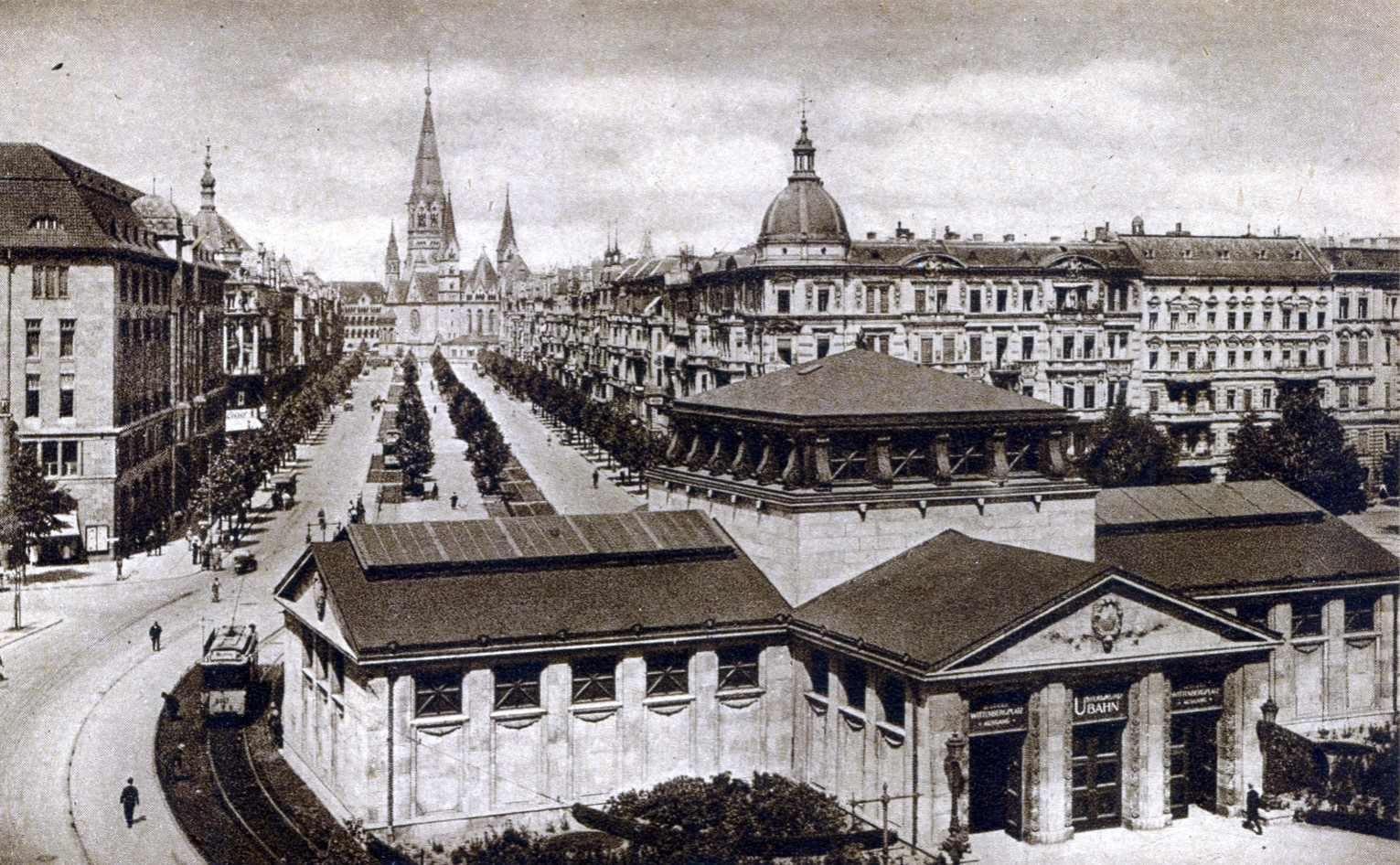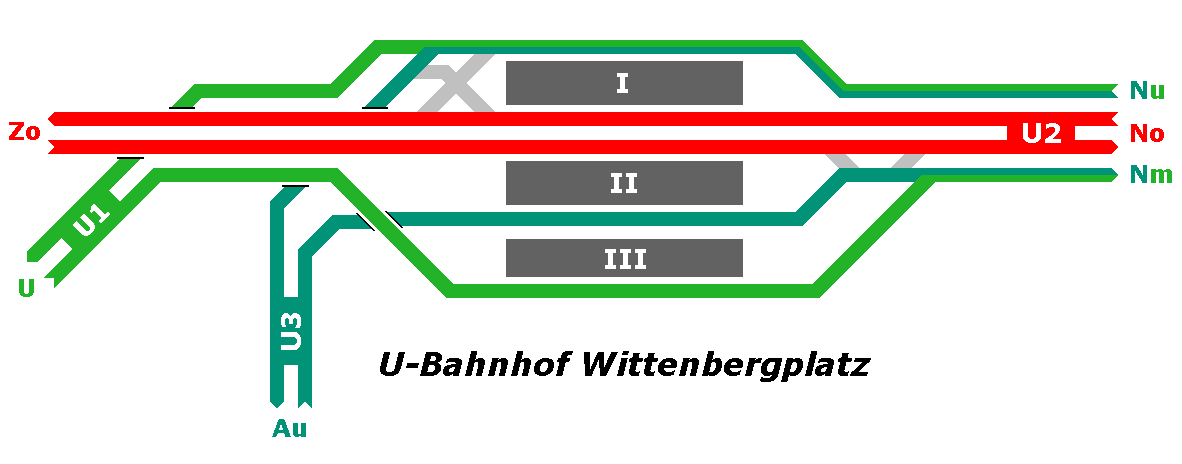Wittenbergplatz (Berlin U-Bahn) on:
[Wikipedia]
[Google]
[Amazon]
Wittenbergplatz is a

 Wittenbergplatz is one of the oldest U-Bahn stations in Berlin, opened on 11 March 1902 with the first '' Stammstrecke'' (present-day U1) line running under the eponymous square and adjacent to
Wittenbergplatz is one of the oldest U-Bahn stations in Berlin, opened on 11 March 1902 with the first '' Stammstrecke'' (present-day U1) line running under the eponymous square and adjacent to  Platform 1 features a sign donated by the
Platform 1 features a sign donated by the
Berlin U-Bahn
The Berlin U-Bahn (; short for , "underground railway") is a rapid transit system in Berlin, the capital and largest city of Germany, and a major part of the city's public transport system. Together with the S-Bahn, a network of suburban train li ...
station on lines U1, U2, and U3. The station is located at the Wittenbergplatz
Wittenbergplatz is a square in the central Schöneberg district of Berlin, Germany. One of the main plazas in the "City West" area, it is known for the large ''Kaufhaus des Westens'' (KaDeWe) department store on its southwestern side.
It was la ...
square in Berlin's City West
City West (formerly known as ''Neuer Westen'' ("New West") or ''Zooviertel'' ("Zoo Quarter")) is an area in the western part of central Berlin. It is one of Berlin's main commercial areas, and was the commercial centre of former West Berlin when ...
area, in the northwestern corner of the Schöneberg
Schöneberg () is a locality of Berlin, Germany. Until Berlin's 2001 administrative reform it was a separate borough including the locality of Friedenau. Together with the former borough of Tempelhof it is now part of the new borough of Tempe ...
neighbourhood. It is the only U-Bahn station in the city with five adjacent tracks and three platforms. The station building, erected in 1911–1913 according to plans designed by Alfred Grenander
Alfred Frederik Elias Grenander (26 June 1863 – 14 March 1931) was a Swedish architect, who became one of the most prominent engineers during the first building period of the Berlin U-Bahn network in the early twentieth century.
Biography
Gr ...
, is listed as an architectural monument.
History

 Wittenbergplatz is one of the oldest U-Bahn stations in Berlin, opened on 11 March 1902 with the first '' Stammstrecke'' (present-day U1) line running under the eponymous square and adjacent to
Wittenbergplatz is one of the oldest U-Bahn stations in Berlin, opened on 11 March 1902 with the first '' Stammstrecke'' (present-day U1) line running under the eponymous square and adjacent to Tauentzienstraße
Tauentzienstraße (colloquially: ''der Tauentzien''; en, Tauentzien Street) is a major shopping street in the City West area of Berlin, Germany. With a length of about , it runs between two important squares, Wittenbergplatz in the east and Brei ...
, today one of the major shopping streets in Berlin. Initially a common underground station with two tracks and two side platform
A side platform (also known as a marginal platform or a single-face platform) is a platform positioned to the side of one or more railway tracks or guideways at a railway station, tram stop, or transitway. A station having dual side platform ...
s, it was completely refurbished as an interchange from 1910 onwards. The new station serving three U-Bahn lines opened on 1 December 1912 with two island platform
An island platform (also center platform, centre platform) is a station layout arrangement where a single platform is positioned between two tracks within a railway station, tram stop or transitway interchange. Island platforms are popular on ...
s and one side platform, serving five tracks on one underground level and under a single roof.
The remarkable entrance hall in the centre of Wittenbergplatz, designed in an Art Nouveau style by Alfred Grenander, was finished in 1913; spanning over all three platforms, it reflected the prestigious building of the large '' KaDeWe'' department store across the street. The station building was badly damaged during the bombing of Berlin in World War II
A bomb is an explosive weapon that uses the exothermic reaction of an explosive material to provide an extremely sudden and violent release of energy. Detonations inflict damage principally through ground- and atmosphere-transmitted mechanic ...
and reconstructed afterwards. Wittenbergplatz quickly became one of the most frequented stations of the West Berlin
West Berlin (german: Berlin (West) or , ) was a political enclave which comprised the western part of Berlin during the years of the Cold War. Although West Berlin was de jure not part of West Germany, lacked any sovereignty, and was under mi ...
urban traffic network, though after the building of the Berlin Wall the present-day U2 to Nollendorfplatz
Nollendorfplatz (colloquially called ''Nolle'' or ''Nolli'') is a square in the central Schöneberg district of Berlin, Germany.
History
The place was named on 27 November 1864 after the village of ''Nollendorf'' ( cs, Nakléřov) near Petrovi ...
was closed in 1972 and not re-opened until 1993. From 1980 to 1983 the station was renovated in line with the precepts of monument perception by architect Borchardt. He won the prize (gold medal) of the Ministry of Architecture in 1986.J. Meyer-Kronthaler, ''Berlins U-Bahnhöfe'', Berlin: be.bra, 1996
London Transport Executive
The London Transport Executive was the organisation responsible for public transport in Greater London, England between 1948 and 1962. In common with all London transport authorities from 1933 to 2000, the public name and operational brand o ...
in 1952 to commemorate the 50th anniversary of the U-Bahn. It features the station's name in the distinctive red-and-blue roundel used on the London Underground
The London Underground (also known simply as the Underground or by its nickname the Tube) is a rapid transit system serving Greater London and some parts of the adjacent counties of Buckinghamshire, Essex and Hertfordshire in England.
The ...
.
References
External links
{{BU-BahnStations U1 (Berlin U-Bahn) stations U2 (Berlin U-Bahn) stations U3 (Berlin U-Bahn) stations Berlin U-Bahn stations located underground Heritage sites in Berlin Buildings and structures in Tempelhof-Schöneberg Railway stations in Germany opened in 1902 Art Nouveau architecture in Berlin Art Nouveau railway stations